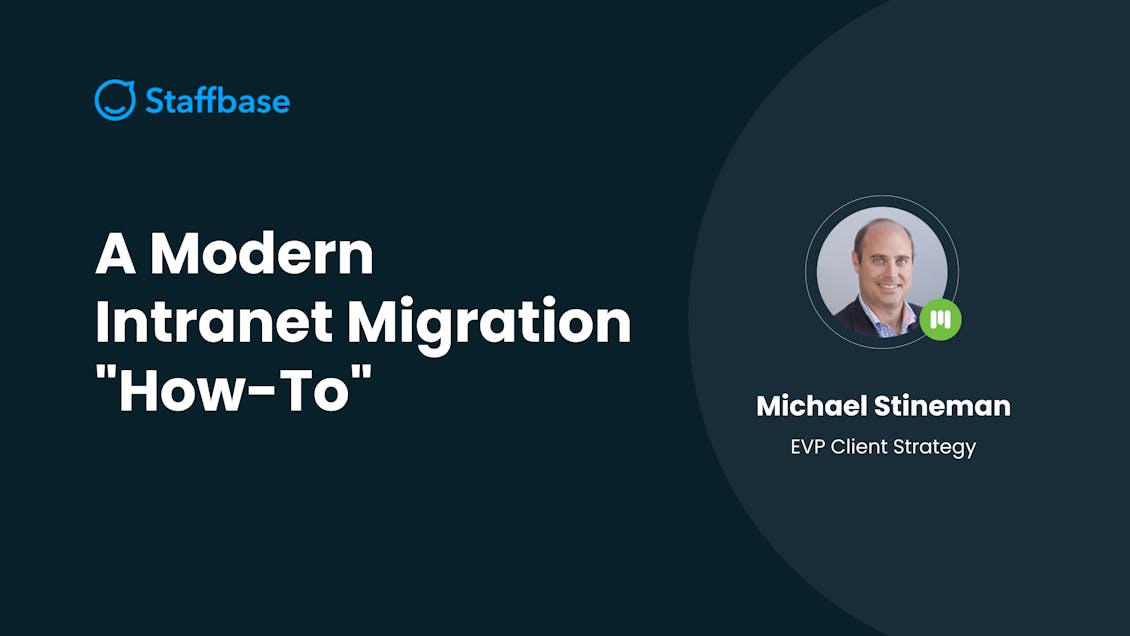Webinar recap: A modern intranet migration with Staffbase

How to plan the rollout of an employee intranet for maximum results
Post-Covid, work culture has evolved. Whether employees are coming into a workplace or working from home, they are being pinged throughout the day with push notifications, chat messages, emails, and more. Add in the multitude of ways that people can work for an organization — full-time, part-time, contract, freelance, seasonal — and it’s no wonder that companies struggle to keep everyone aligned and engaged.
This is the business case for an employee intranet, often an app or a portal for company communication and resources. As Modus has decades of experience in designing, building, and implementing intranets for clients, Michael Stineman, our EVP, Client Strategy, was recently invited to lead an intranet migration how-to webinar with Staffbase’s Sebastian Hoff, Principal Strategic Advisor, and Tracey Kapshey, Team Lead, Customer Success, Large Enterprise.
Here’s a preview of “A Modern Intranet Migration How-To.” You can find the full recording on Staffbase’s Youtube channel. Modus is a proud partner of Staffbase, a leading internal communications platform.
Step 1: Intranet content audit
So, let’s imagine all of the upfront planning to switch intranet providers has been done, and you’re ready to migrate content from your old intranet to your new one. Where do you start?
“I think the first step, which is often missed, is really understanding what content exists on the old internet,” says Stineman. “You ask anyone from the different groups in the organization and they all have a different view of what lives on an intranet, depending on how old it was. … “Is it a wiki? Is it a file share?
“One of the key things is to do a really good audit. And, hopefully you can use a tool to crawl it and understand it, if not, have someone come in and actually map it out. Because what you'll start to see is some patterns that emerge, right? You'll have ‘n’ number of the same types of articles. So if it's a monthly newsletter or it's a quarterly report, and you'll have 10,000 monthly newsletters or whatever it is depending on how long the piece is. So I think the first place to start is really to get that super set of that list.
“And then from there, you have to determine who is going to be responsible for sort of the keep/kill/edit breakdown. … The migrations often serve as a spring cleaning, right? There's a lot of outdated corporate information. Which from an HR compliance perspective, you want to get rid of it… But there's also a lot of stuff that maybe gets used a lot.
We also recommend looking at your analytics. If you don't have analytics on your old intranet, now's a good time to turn it on to see what people are actually using.
Hoff added that organizations may want to set up some simple rules around the migration process, for example, only migrating 10 percent of old content. “It could be that we're saying, ‘Okay, we are looking at the analytics and we're deciding everything which hasn't had over 100 views over the last month will just be deleted.’
“To have those kinds of rules and guidelines helps also to explain to content owners: Why are we doing this migration the way we are doing this? And why do you have to throw the old content away?”
Step 2: Make time for content editing and restructuring
“It's not just looking at content for content's sake,” says Stineman. “A lot of times you need to analyze things like, does this have a new home in the new intranet? [Something might have] important information, but it needs to be broken up into three different pieces because the structure and the design that's coming out of the new intranet is really changing how we're communicating. Whether that's an internal reorg by divisions or by product or by business unit or location. Sometimes you have to say, hey, well, we need to keep this but it has to be repackaged, or, we need to keep this but actually we need 10 more versions of it. Because you know, we're operating in multiple countries now, or we have different jurisdictions that we have to handle. So it gets a little bit more complicated.
“The first pass is always good, like, oh, we definitely need this. And then there's that second pass, where you start to say, well, can this be repurposed? The other one that I always love when I'm working with clients that they're surprised at is, well, we have all these PDFs. We're like, well, one of the reasons we're making you a new intranet is so that it's all searchable, and it's not in PDF. So yes, you have the content, but now we have to start to think about how are we going to structure that, what are the pieces that need to get pulled out, and starting to think about that business process as well as how it's going to get into the new format that we want to get into, that’s sort of the target.”
Step 3: Curate intranet content for the user experience
“You really have to think about it in terms of your endgame,” says Stineman. “What is your KPI for the success of the intranet? It's not just about migrating old content. If that was the case, most intranets that got migrated would not be successful. … What information that's new is being added to the intranet because it’s interesting?
“When we look at analytics and we do user research — and I think that's an important piece, talking to the end users of the intranet and not just the stakeholders who own the content — when you talk to the end users, very different stuff bubbles up. So my favorite one, and this has happened on probably 10 or 12 intranets, one of the most common questions is, ‘What's for lunch in the cafeteria today?’ ... And so little things like that, those little moments of delight, you know, that we expect from other systems that we use, to have that pop up when I come in and like, ‘Welcome Mike, today's lunch special is the cod’ or whatever it is, you know, those things can really make or break.
“So when that pops up, and I also get the message from my CEO or my department head, well, now I'm starting to see like, ‘Oh, this is active. It's updated in real time.’ You know, a lot of thought has gone into it, which is going to make me, as the employee, really kind of buy into it more and get more value out of it.”
Step 4: Consider intranet integrations
Beyond menus, intranet must-haves today include an employee or partner directory that makes it easy for users to connect with and locate others in their system. Other popular intranet content includes third-party service apps such as employee benefits and wellness providers.
“A lot of times there's these online services where you can have telehealth, and you can incorporate those into the intranet,” says Stineman. “If you're spending money on these benefits, why not put those in the intranet and make them really easy to access? It can be single-sign-on, or even just the redirects — just have them link out, and a little blurb about what the service is. I think we see a lot more of that, because we're so focused on providing employees with the best possible benefits and services and thinking about them holistically now, not just as like a time clock puncher. If we can, keep them happy, and you know, we're paying for these services. So let's get the usage out of it.”
See more
Be sure to watch the full webinar recording, which includes tips on optimizing your internal brand and content strategy for your intranet, as well as best practices for maximizing employee engagement with your shiny new intranet.



